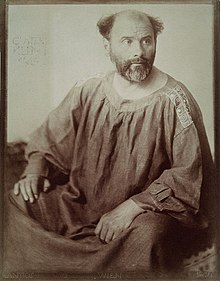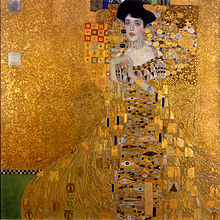By Rowanne Reifman


SAN DIEGO — In early February, art collector Ronald Lauder, who also is the president of the World Jewish Congress, agreed to return and then repurchase Gustav Klimt’s painting titled The Black Feather Hat c. 1910 from the descendants of Irene Beran, a Czech citizen who owned it until the beginning of the Nazi era. The amount of the re-purchase was not disclosed.
Back in 2006, Lauder, heir to the Estée Lauder cosmetics fortune, also made art history when he paid $135 million for Klimt’s Portrait of Adele Bloch-Bauer c. 1908. It was the largest price paid at auction for a painting. The artwork became even more famous through the 2015 movie “The Woman in Gold” starring Helen Mirren.
It’s not only art collectors such as Lauder that find Klimt’s artwork beautiful. The genocidal dictator Adolf Hitler also found Klimt’s artwork desirable.
So, who was Gustav Klimt?
He was an Austrian artist who studied at the Vienna School of Decorative arts and was a founder of the Vienna Secession movement, a progressive art movement that strayed from the conservative artist organizations of Germany and Austria.
According to The Art Story website, he was the second born of seven children, and he grew up poor. His father was a gold engraver and believed his sons should become artists. Klimt and his brother took many art classes and showed talent. In 1876 Klimt won a scholarship to attend the Vienna School of Arts and Crafts (his brother would later attend as well). There, he studied the works of one of his favorite local artists, Hans Makart, until he left school in 1883.
In Klimt’s early art career, he had stayed within the realm of his teachings, not straying far from the conservative art styles that he was taught. He had specialized in mural paintings, and he was commissioned to paint three murals on the ceiling of the University of Vienna. As reported on Britannica however, he was heavily criticized for his final product as it had ‘erotic’ symbolism and his murals were rejected.
Around 1897 the Vienna Secession had started to begin and Klimt joined it. It was around this time Klimt had begun his German expressionist paintings and began to experiment more. Around 1902 Klimt created a piece in honor of Beethoven which had a heavy gold background. That sparked his obsession with gold leaf backgrounds, inspired by early Byzantine art. His most famous artwork, The Kiss (c. 1908), is just one prime example of this obsession. Throughout his time as an artist, he accepted many commissions from Jews, as well as having many female Jewish models for his paintings. Klimt continued making art all the way until his death in 1918.
It’s no wonder why Klimt’s artwork is so loved in the art world and by art collectors alike. Klimt’s art evokes a feeling within the viewer of warmth and welcoming, encouraging many to step out of their comfort zones and be bold in expressing themselves.
Fifteen years after Klimt’s death, Hitler came to power as the chancellor of Germany. Before Hitler turned to politics, he had been a painter. He was rejected twice by the Art school in Vienna, and while he decided to let go of his dreams as an artist, his love for art was still evident throughout his brutal reign.
During World War II, Hitler mandated that culturally significant art from other nations was to be obtained, either willingly or forcibly, in order to seize control of not only the people of that nation, but of the art world as well. According to the United States Holocaust Memorial Museum the Nazis uncoincidentally stole art primarily from private Jewish families.
Hitler had his minions collect art for two different art museums. One was the Linz Art Gallery, which was filled with art that had reflected Nazi ideals and traditional German values. The other contained art that the Nazi’s considered to be “degenerate,” suggesting that the artists’ mental or moral capacities were in “decay.”
Art styles featured in this museum ranged from modern to cubism to his least favorite, German expressionism. Works by Picasso, Matisse, and Kirchner were displayed. Over 600 works of art by Kirchner were seized by Nazis and were either destroyed or displayed in Hitler’s “degenerate” museum. Distressed, Kirchner fell into a deep depression and killed himself shortly afterwards. However, Klimt’s art managed to ‘escape’ such a horrid museum.

Why, of all artists, did Klimt get special treatment? Historians still are not quite sure. He was a German expressionist after all and had many close relationships among Jewish people. Even one of his most famous paintings, Portrait of Adele Bloch- Bauer 1 c. 1908 is a painting of a beautiful Jewish woman, commissioned by a close Jewish friend. When the Nazis seized this painting, they had stripped the painting of its original name and renamed it to what it is commonly known as now, Woman in Gold, to excise its Jewish history. The Blogs Brandeis suggests that politics alone is what saved the artist from his art being deemed “degenerate,” as some of his art did reflect many traditional German values and wasn’t seen as a threat to Hitler’s regime.
After World War II the Allies worked hard to recover much of the stolen art. According to Wikipedia the Monuments, Fine Arts, and Archives Program (whose agents became known as the Monument Men) helped recover and relocate much of the art. However not all the pieces were returned to their original owners. Many Jewish families worked hard to reclaim art that had been owned by their family members. As stated in the Smithsonian Magazine, the HEAR Act (Holocaust Expropriated Art Recovery Act) of 2016, has made it easier for Jews to recover art that is rightfully theirs.
*
Rowanne Reifman is a graduating senior at Patrick Henry High School in San Diego deciding which university to attend for courses in art and journalism. She has been accepted for admission by many.
Excellent piece of journalism, capturing the essence of the artists talent and the history of his work.
Pingback: Art of Gustav Klimt Has Long Been in Demand – The Art Connoisseur